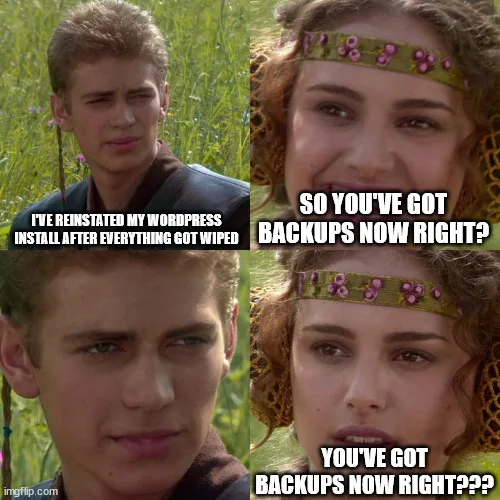There are some of you who have been subscribed to this blog’s feed for many, many years. I started writing a blog way back in 2002 – back when Web 2.0 was just starting to become a thing – and kept it going for almost 20 years.
And then a botched server upgrade resulted in everything being wiped, including my backups.
It had been my intention to try and salvage what I could; after all, many of my old blog posts should be in the Web Archive, and in other places across the internet too. But working full-time and being a dad just doesn’t leave much spare time, and I tend to prefer to use my free time to consume media (mostly reading) rather than producing new blog posts, or, more pertinently, bringing back old ones.
But it isn’t just a time issue. If I ended up taking a sabbatical from work, or parental leave, then I still wouldn’t go back to re-fill this blog’s arhcives. I’ve made a decision that what happened has happened, and I’m drawing a line under it.
There were some good blog posts over the years, that generated a lot of comments and links at the time. Others highlighted key points in my life; graduating university, relationship milestones, becoming a father and so on. But, my reasons for not undertaking blog archaeology are as follows:
I don’t stand by some of the things I wrote
I wrote more than one post about enjoying the DVDs of various sitcoms written by a well-known comedy writer in the 1990s and 2000s. Unfortunately, said comedy writer, who I am not going to name, is now a major figure in the pushback against rights for trans* people in the UK, and as a member of the LGBTQ+ community myself, I can’t support that. This is just one example, but my opinions have changed over the years, and I don’t really want to go back and revisit what I’ve written on some topics. Especially things like my changing relationship with Apple products, and politics.
It’s worth noting that, when I started my blog in 2002, I was only 17 – I’m now fast approaching my forties, and with that comes more wisdom and knowledge of how the world works, and being aware of my priviledges as a white, middle class cisgendered male person.
I also don’t think that people really want to read about how much alcohol I was drinking in my early years at university, or the regular apologies for not blogging as often as I thought I should.
There are things I wrote about that I don’t want in the public domain anymore
Being a parent and the responsibilities it brings changes you as a person – just ask a neuroscientist. Early on, I talked about and shared photos of our child in a way that I wouldn’t do now; nowadays, I try to keep much of their identity off the internet – including their name and gender. They haven’t consented to that information being out there, and are too young to understand the implications of consent. And I wouldn’t want them to read things written about them when they’re older that might upset them.
In my previous relationship, between 2005 and 2009, we agreed that I would only use a pseudonym when talking about my partner, and though we separated nearly 15 years ago, I still consider myself bound by the conditional consent that we agreed at the time. Maybe when our child is older, we could agree something similar.
Some stuff is really out of date
Early on, I tracked the development of the development of the web browser that would become Mozilla Firefox, and blogged about the changes in each beta release in great detail, up to the release of version 1.0 in 2004. But after almost 20 years, so much has changed; the screenshots I took are probably all gone too, and so I don’t think there’s a lot to be gained by bringing those old posts back.
Because I’ve always had an interest in technology, there are many old posts that I’ve written that are outdated. I’m sure some contain advice which, if followed today, would be actively detrimental rather than helpful.
Perhaps, if I somehow managed to get the time and resources to bring back the really good posts, it would be worthwhile. But there would be a lot of poor quality content to sift through, and I certainly wouldn’t want to bring anything back without reading it first.
Seeing as how the likelihood of me having that time is low, then I have had to make peace with the fact that all that content is going to have to remain scattered to the digital winds of the internet. And that’s okay.
An update (January 2024)
Okay so I’ve already gone back on my word and started bringing back some old posts. My aim is to re-instate blog posts that are still getting traffic – I’m tracking dead links in WordPress and Google Site Console, and if they’re linking to things that still have value, I’ll re-instate them. I’m also aiming to have at least one post from each month, going back to January 2002. Overall, I may bring back about 1-2% of what was here before.











